The Art Detective
Her Art Was Once Viewed as “Obscene.” Now Martha Edelheit’s Nudes Are Finally Gaining Acclaim After Decades in Obscurity
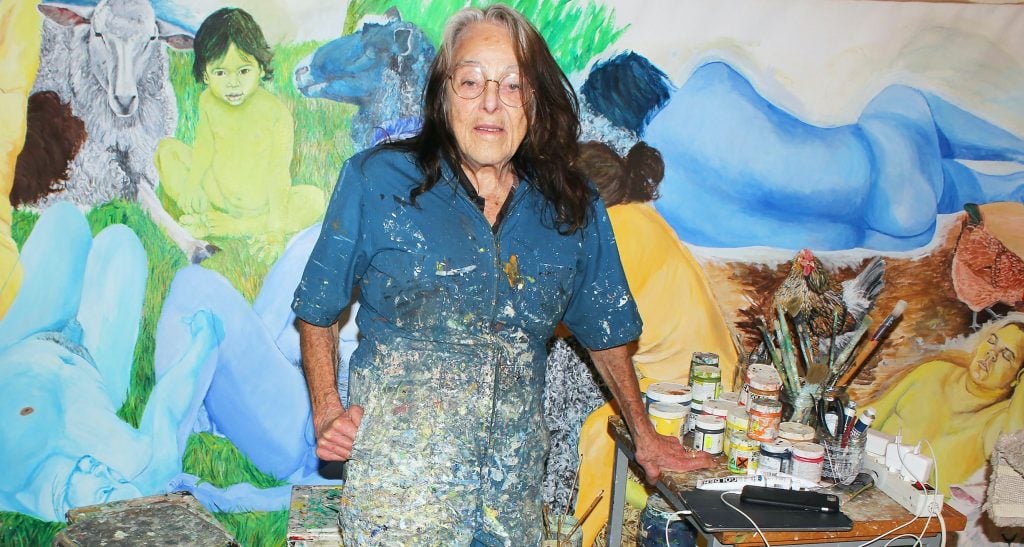

I am rooting for Martie Edelheit.
At the age of 91, she’s finally emerging from years of obscurity. Her mind is clear and her body agile enough to enjoy every small step of it all—a bustling opening, a post-opening dinner at the fashionable restaurant Il Buco—while leaning on a cane, or a friend’s arm. Small, fierce, outspoken, Martha Edelheit keeps pushing forward, with new 11-foot paintings and a planned return to New York City, her hometown.
I first encountered Edelheit in the context of another story, which explored the asymmetry of market acclaim for female artists based on the findings of the Burns Halperin Report.
As I wrote in December: “The overwhelming majority of women, especially women of a certain age, are ghosts as far as auction sales go. The reasons for this vary, from the market’s preference for painting over conceptual and performance art to lack of access to the gallery system to individual choices to slow artistic production during child-rearing years.”
Edelheit came to my attention because she wasn’t listed among more than 2,000 women surveyed in the report. That’s because not a single one of her works has come up for auction since she started making art some 70 years ago.
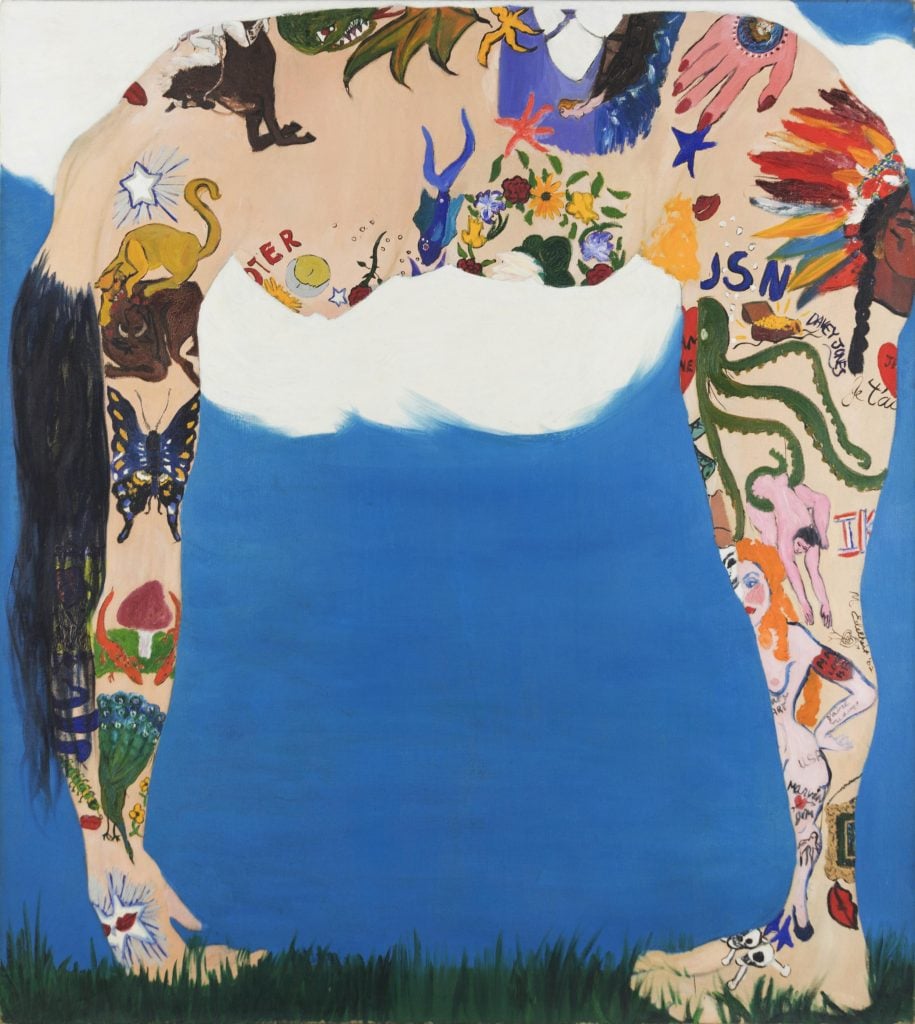
Martha Edelheit, Tattooed Lady (1962). Collection of Beth Rudin DeWoody via Eric Firestone Gallery
© Martha Edelheit / Artists Rights Society (ARS), New York.
But things are changing. This week, Edelheit’s solo show “Naked City: Paintings from 1965-1980” opened at Eric Firestone Gallery in Manhattan, with prices ranging from $20,000 to $500,000. Her 1962 painting, Tattooed Lady, was a recently a star of “New York 1962-1964,” an exhibition at the Jewish Museum exploring the rise of Pop Art. A limited-edition print based on this work and priced at $2,200 just came out on Her Clique, with half of the proceeds benefiting Planned Parenthood and Doctors Without Borders. Next month Edelheit’s early abstract paintings will be part of “Action, Gesture, Paint: Women Artists and Global Abstraction 1940-70,” a survey of an overlooked generation of 81 international women artists at the Whitechapel Gallery in London.
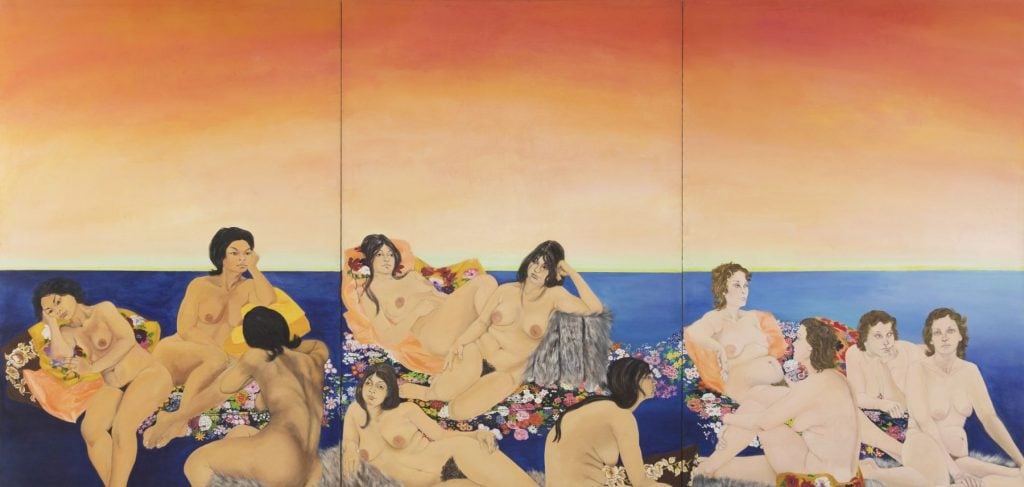
Martha Edelheit, Women in Landscape (1966-68). Courtesy of the artist and Eric Firestone Gallery, New York.
“A lot has happened for her in the past five years,” said Eric Firestone, listing strong sales from her first exhibition in 2017, multiple museum acquisitions, scholarly texts, and upcoming institutional shows.
Edelheit’s figurative paintings still shock, irk, dazzle. The naked body is there to behold in all its glorious detail— every pubic hair, skin roll, and nipple—on a scale that succeeds in being both monumental and intimate. The models look relaxed as they lounge and recline, enveloped by verdant foliage or sumptuous fabrics. One canvas, Women in Landscape (1966-68), consists of three panels and measures almost 17 feet across.
“She’s taking gestures, poses, compositional framework from the Renaissance and redoing them around these concerns of the body and the self,” said art historian Melissa Rachleff, who included Edelheit in “Inventing Downtown: Artist-Run Galleries in New York City, 1952-1965,” at the Grey Art Gallery in New York in 2017. “When you look at her works compositionally, you see Dürer, you see Rubens, you see Botticelli.”
Edelheit said her interest in the naked body has been keen since childhood. She was one of those girls who immediately undressed and dismembered a new doll. “I was looking for genitals,” she said. “But all dolls were neutered.”
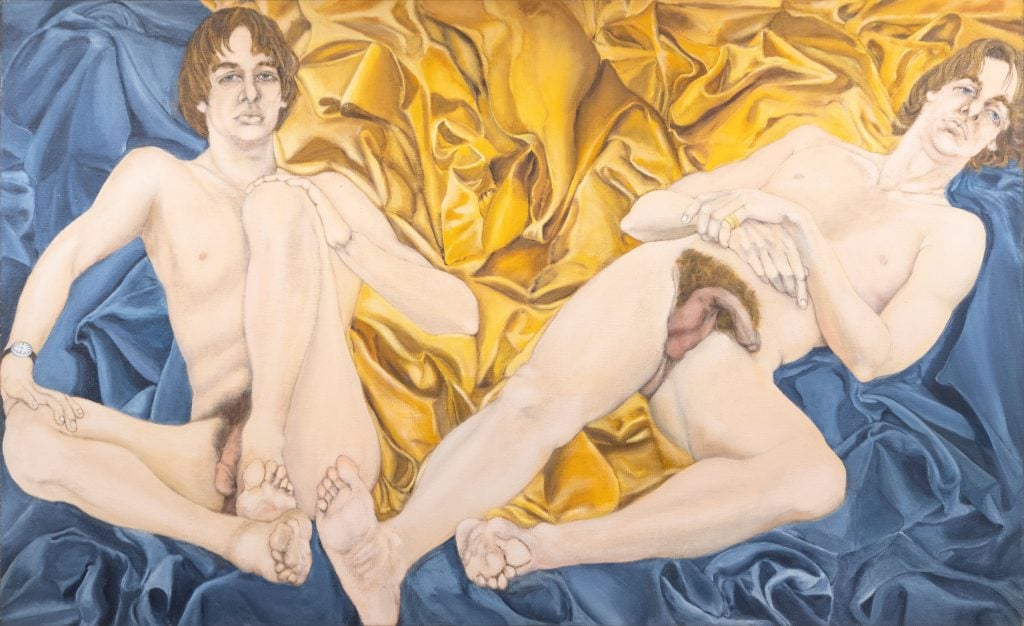
Martha Edelheit, David x 2 (1971). Courtesy of the artist and Eric Firestone Gallery, New York.
Her early works in the 1950s were abstract paintings that owed color sensibility and compositional patchwork to Michael Loew, an American artist who lived on the island of Monhegan in Maine. Edelheit and her first husband, psychoanalyst Henry Edelheit, visited Monhegan in the summers.
“We were sharing a house,” she recalled. “He had a studio on the first floor, and we were on the second floor. There was a balcony, and I would look down and watch him work. And I learned more about painting by watching him work than I learned any from any class. He was what they called back then a Neoplastic painter, a disciple of Mondrian.”
In New York, Edelheit was becoming part of the avant-garde scene, a member of the Tenth Street artist-run space and its offshoot the Reuben Gallery, where she had her first solo show in 1960. She was friends with Susan Sontag, the first person she met as a University of Chicago undergrad, and artists Carolee Schneemann and Rosalyn Drexler. Her male peers included Claes Oldenberg, Lucas Samaras, Jim Dine, Robert Rosenquist, and Allan Kaprow.
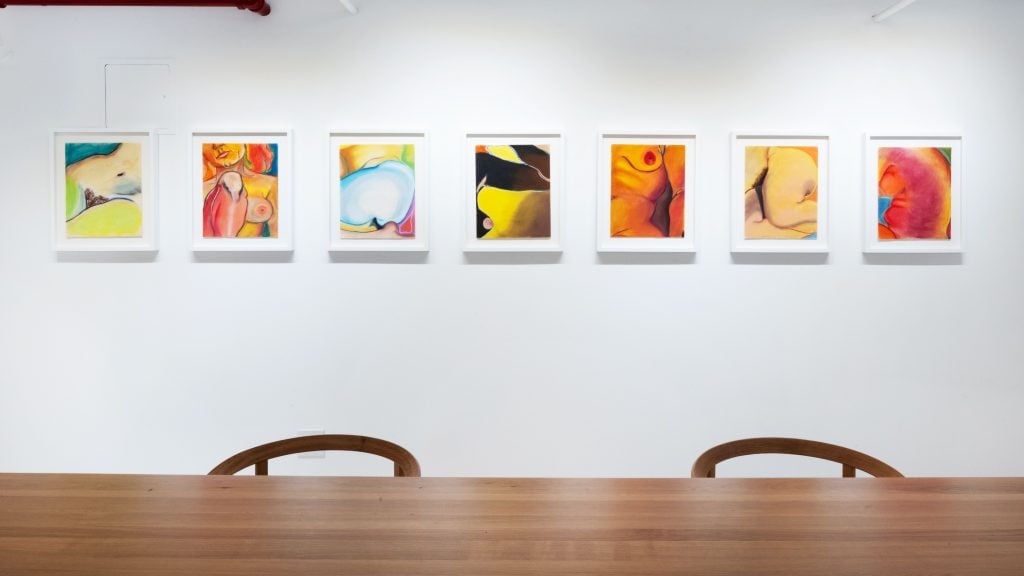
Installation view, “Martha Edelheit: Naked City, Paintings from 1965-1980” at Eric Firestone Gallery, New York.
“As she befriended artists who were engaged in performance and happenings, those exchanges opened up a space of possibility for her to consider the body,” Rachleff said.
Despite her active exhibition history, Edelheit sold very little art and was rarely reviewed while “the boys all got galleries and moved uptown and into the museums,” she said.
It didn’t occur to her that this had something to do with gender because she didn’t see herself as a female artist—she simply thought of herself as an artist.
The feminist movement opened her eyes to gender discrimination. Initially reluctant to join it—she was “dragged in kicking and screaming,” she said—she became an active member.
“I was forced into it because of what was happening with women artists,” she said. “Not just me, but all the women artists I knew.”
The overt sexuality of her artworks—later dubbed “radical eroticism” by art historian Rachel Middleman—was also a complication.
In 1966, a New York Times critic spent more than two hours at her exhibition at Byron Gallery uptown only to inform the gallery owner that he “can’t review that obscene woman,” she recalled. “Charles Byron had a show in his office of a guy who did postcard-size landscapes. So, he did a review of that.”
An event that had a profound impact on Edelheit’s life and art took place in 1957, when her younger brother, Robert Ross, suffered a horrific motorcycle accident while on vacation in Sweden. He spent months in a coma and years in rehabilitation. A Korean War veteran, he was treated in U.S. military hospitals that were filled with crippled servicemen. What she saw there while looking after him found its way into her works on paper from the early 1960s.
Her “Children’s Games” series of ink drawings are filled with headless, limbless figures doing horrible things to themselves and each other. Masked amputees appear in her ink-and-watercolor works like Bird House With Baby (1962) and Dream of the Tattoo Lady (1961). The chains and masks in these works are suggestive of sadomasochism.
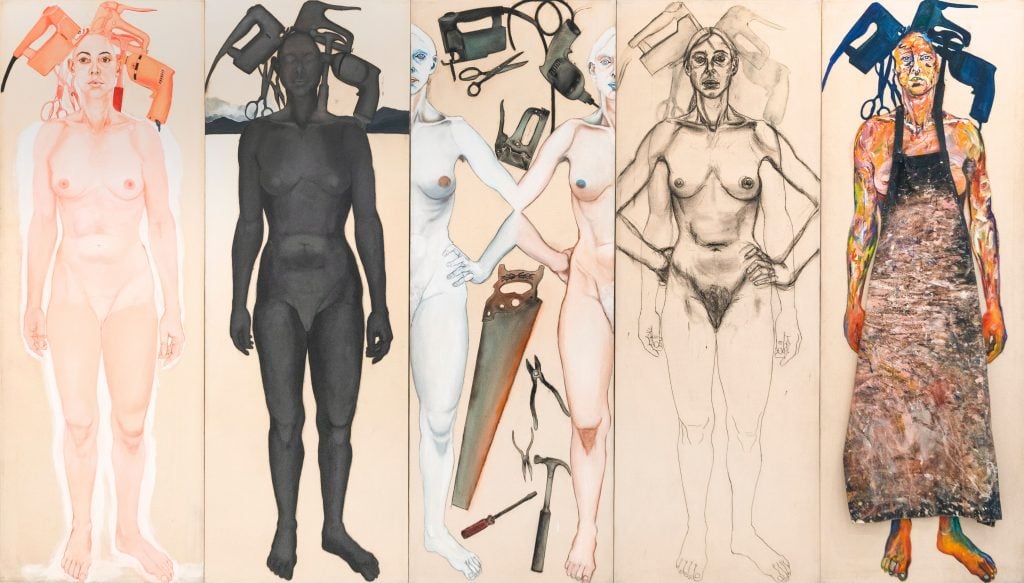
Martha Edelheit, Self Portrait With Tools (1975). Courtesy of the artist and Eric Firestone Gallery, New York.
“I wasn’t thinking about S&M,” Edelheit said, explaining instead that “masks were a way of not having to show the emotions of the figures represented.”
The circus, which she loved as a child, was another frequent theme.
“Back then, before you walked into the circus, there was what they called the freak shows,” she remembered. “That’s where you’d see the world’s tallest man, the world’s fattest woman, a two-headed dog or a two-headed cow.”
That’s where she also first saw tattooed people.
“I was hypnotized by them,” she said. “The idea of painting your body, of marking your body forever was really a powerful image for me.”
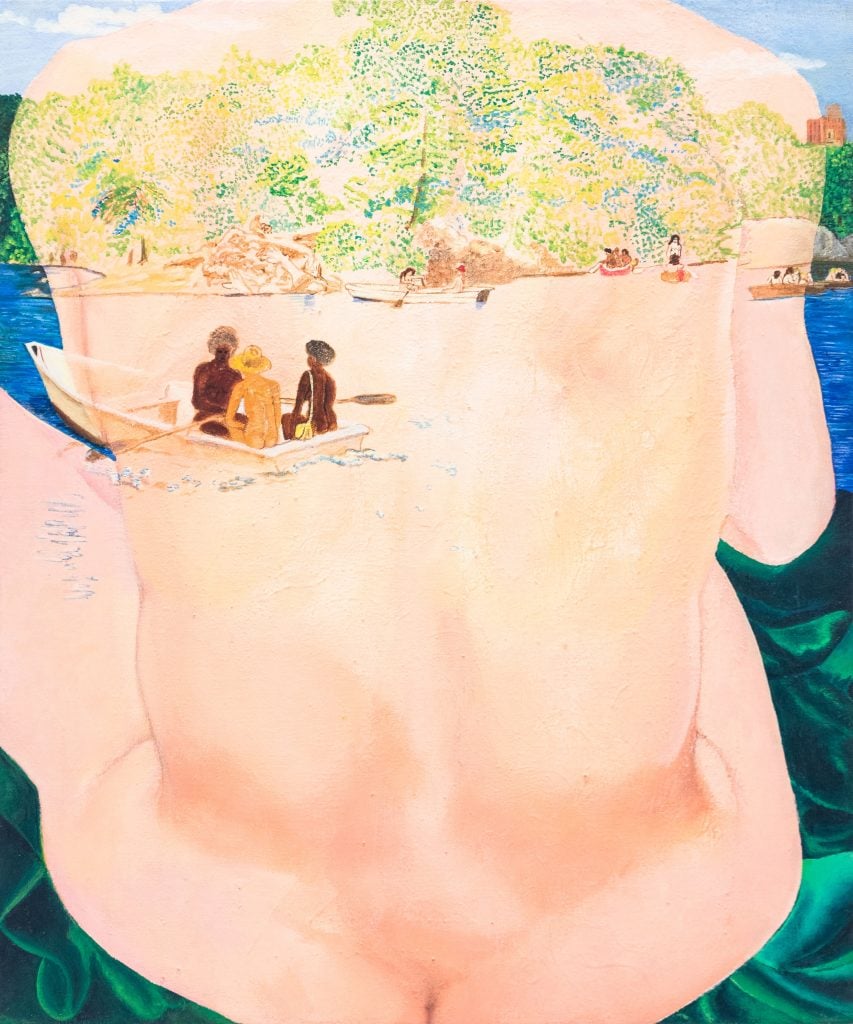
Martha Edelheit, Boating Central Park (1973). Courtesy of the artist and Eric Firestone Gallery, New York.
She began exploring tattoos in earnest in 1962 with a series of “Tattoo Paintings.” She painted tattoos on mannequin hands, arms, and legs as well as in her “Back Paintings” of 1972 to 1975. Several of these works are now on view at Eric Firestone Gallery.
Tattoos were not just a decorative trope, according to Jennifer Samet, who works closely with Edelheit and organized both of her shows at the gallery.
“The paintings become this arena in which she can depict not only their bodies, but their ideas and dreams,” Samet said. “She used imagined tattoos as a way to tell those dreams.”
Edelheit spent the past 30 years in Sweden, where she moved after her first husband died and she remarried. She met her second husband, Sam Nilsson, years earlier, after her brother’s accident. A budding journalist, he would go on to become the head of Swedish public broadcasting and a prominent figure in the media and culture circles. Edelheit unexpectedly found herself in a new role, attending Nobel Prize galas and having dinners with the country’s king and queen.
“It’s like someone handed me a movie script,” she said. “All of a sudden I had a closet full of evening gowns.”
Her art had to adjust as well. She settled in a remote area on an island, with the nearest bus stop seven kilometers away. This wasn’t the kind of place where she could ask a neighbor to strip and model for her.
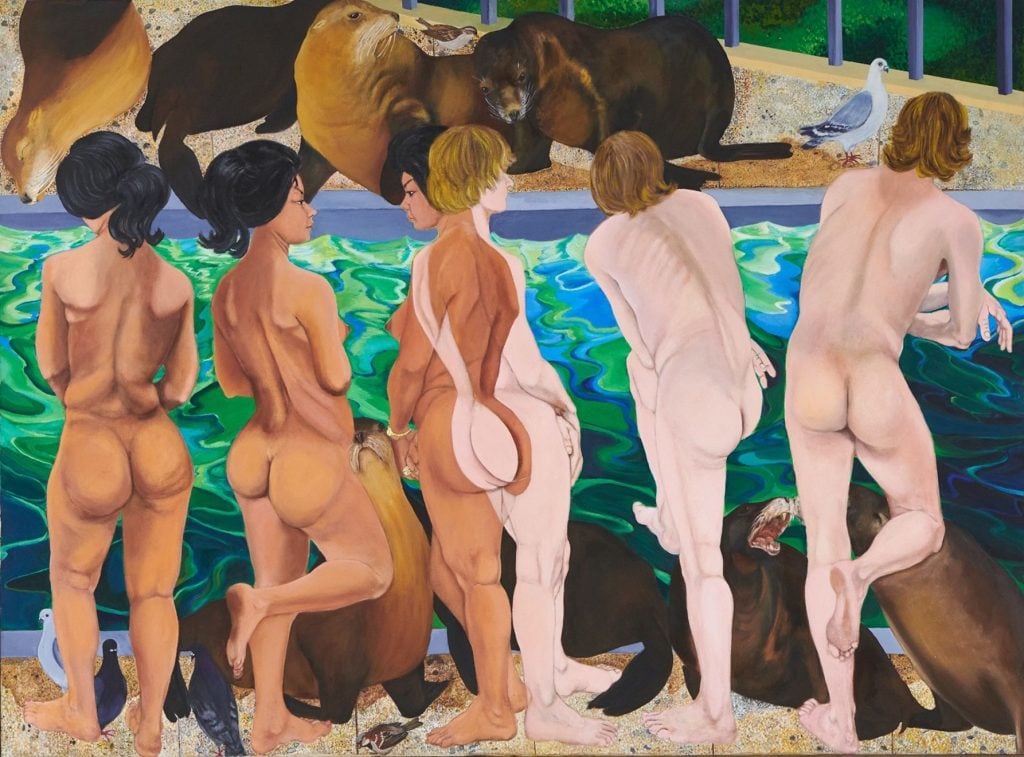
Martha Edelheit, Seals, Central Park Zoo (1970-71). Courtesy of the artist and Eric Firestone Gallery, New York.
“I think it was Rubens who said, ‘I paint what’s in front of my nose,’” she said. “And I looked out the window and what was in front of my nose was sheep. So, I did. I’ve been working with sheep and landscape for the last umpteen years.”
She used materials she found in her environment, making canvases out of chicken wire and papier-mâché and creating a lot of wire sculptures of sheep.
Now another change is looming. Following Nilsson’s death in 2020, Edelheit wants to return to New York. She spent several months in the city coinciding with her exhibitions at the Jewish Museum and Eric Firestone.
The stay brought back the memories of all the people who used to be part of her life, the models who became her friends, the 5,000-square-foot studio at the Hotel Wales on Madison Avenue and East 92nd Street (where she paid $125 a month in rent).
Once again seeing the paintings she created in that studio has been intense.